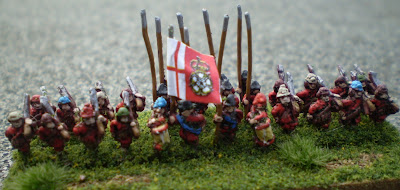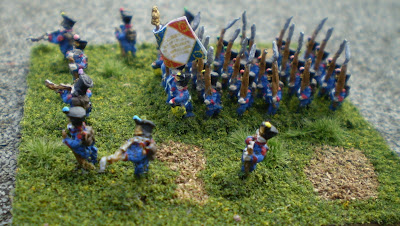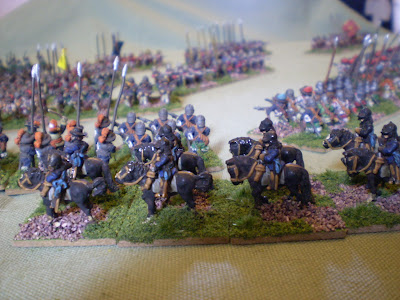With the mixed aids of satellite navigation and the great picture heavy directions provided by Peter we turned up at Baccus HQ about ten minutes before kick off. As we climbed out of Lee's car a lonesome soul enquired if we were here for the Baccus Open Day. Well me being the type I am and the other guys open friendly face just demanded the guise of ignorance, soon foiled when I asked if we looked like wargamers! Lee, Cath my wife and I had travelled the fairly short distance to the HQ in a little over 30 minutes so it's fair to say we were local, I think the furthest away anyone travelled was from Luton.
Not knowing what to expect but knowing it would be both interesting and fun we trooped in and the first imprecision was how small it was. OK I never expected it to be large but compact would be the way a Estate Agent would describe it. Space and set up though allowed the whole group good access (about 10 of us) and the whole tour was comfortable. The first thing we were charged with (after being given our brews) was doing the whole AA meeting bit. "Hi my name is Ian I have been a gamer since...." The striking thing was how many of the people there were normal, you would not pick them out in a crowd. Two none combatants were there out of the group though Cath was there more through her own interest in the process than just to make numbers up which showed as she asked questions and paid very close attention. Peter was both informative and entertaining in the right measure and was a joy to listen too. He has obvious passion for what he is doing and pride in his achievements.
So first impressions post the size of the workshop. The moulds, and they have a lot of them. Again had no idea what they would look like but they are well big. Then it's the lack of obvious machinery, no banks of boiling lead, no big boxes covered in flashing lights and churning noises. This could be any small workshop but just as easy a Taxi Cabs office! The thing that gave it away was the display cabinets of painted figures and the figure racks ready for the next show. Now don't take from these words that any kind of feeling of disappointment or let down, just one of anticipation. Kind of you know the magic trick is about to be performed but you have no idea on how it will be done, or really on who.
Once the AA meeting side of it had wound up Peter then gave us a potted history of Baccus that is well worth repeating. Peter was made redundant in the 80's version of today. He somewhat like me did not want his brain turning to mush and like me he was off for quite a long time so he started to make buildings in the scale so close to his heart. So one great looking building would take up to three weeks to make and then when he turned up at a wargames con trying to sell these 25mm gems he would be offered way below what it was worth to make. He just could not command a fair price for the buildings, no one questioned the fairness of the price but especially then, wargamers are tightwads on the whole when it comes to terrain and buildings (my words not Peters). Next he looked at making Masters instead of sale pieces. Then make and sell resin versions of them. He ran the cost's and still they would be too expensive. So he dropped the scale to 15mm, ran the costs, still too expensive. OK how about that new scale 6mm (grimace grimace) and sure enough finally he came up with a scale that could be made, sold at a price we would pay and still make something of a living off.

These are some examples of the buildings and fortifications Baccus produced. Whilst Peter was a die hard 25mm wargamer and this to an extent went against the grain he knew he had a product he could sell. One thing he was more than a little taken back was in some cases the outright aggression he was greeted with when he started to show the pieces at wargames cons. He was sharing space on Wild Goose trade stand and indeed running the stand for the owner. Peter suddenly had the polarisation that 6mm can cause brought to his attention. Some time later he worked with a figure producer who offered to make 6mm figures to compliment his resin models. This worked for some time but the quality and standard of quality control were not up to the standard Peter felt was acceptable. The long and the short is that Peter tried his hand at sculpting and discovered his skills went beyond the buildings so he created his own range getting someone else to turn the Masters into moulds and started to supply his own range. As this became more successful he sold off his resin designs and took on the whole creative procedure from figure sculpting through mold manufacture to sale of figures.
From here Peter took us to the actual figure production area, so what follows is the full process from Figure Sculpting to final production. I will go picture heavy saving you from as much written word.
Masters or Greens as they are also known. The three shown here are 54mm, 25mm and a real life Baccus 6mm. These unlike the plastics have to be done the exact size you intend the finished figure to be. So any detail you see on a figure, that is what the sculptor has done at the size shown! Can you guess what the figures are standing on?
This is the vulcaniser that is used to make the moulds. Either Master Moulds or regular production ones. Peter is pointing at one of the hot plates, these heat the rubber mould sections to 150 Celsius whilst the bottle jack below put the mould under intense pressure.
Here you see the whole machine with the bottle jack below. The pressure is so intense that it often smashes the Green so it is very often a one shot attempt to get this stage right. Whilst most figures break up in the process they maintain their integrity whilst under pressure so you still get a perfect Master Mould. The
cooking process lasts for a couple of hours in which time the mould material goes from a flexible mouldable rubber to a somewhat fixable but rigid pie. The mould is made up of two of these discs and whilst under all that pressure and heat they do not become joined together. Brass studs have to be inserted in one of the mould sections so that the two halves can be lined up perfectly.

Here is the Green that was in a previous picture and a cast figure from the mould that is made from the Master Mould. Once the Master Mould has been created channels have to be cut in the mould for the lead to run from the centre where the lead is poured to the figure itself. This is a important task and one that if done wrong means the mould will be scrapped and if the master broke up in the process, well back to the sculpting table! Add to that you have about ten minutes to get this done, after that it is very difficulty to cut the mould as it has taken on it's new properties. The mould is then tested and if all went well a number of sample
spins are done so that the very best casts can be selected for making a second Master Mould. This is a requirement for any figures that are produced in strips as the strip base needs to also be made. This is often done with a material such as miliput. The whole vulcanising stage has to be gone through again (but at least you now have the master mould if things go wrong). Once this master mould is made then the process of casting a number of samples is done again. The very best are selected and at last a production mould can be generated. Yep repeat the process and remember at each stage if the channels are not cut well or fast enough then it's thrown away and the stage needs repeating. Nick the caster told us that each mould has it's own character and to get the best results from a mould he may have to spin at different speeds, use lead at different temperatures or even spin the mould in the reverse direction. Notes are written on the moulds with the strangest requirements!

This is the main casting machine. It seems to be a very basic piece of kit and indeed it works on a basic system but is rather clever for all that. The hatch is up showing the wheel that spins the mould. Note the pouring hole in the lid.
The mould is held in place by three clamps (look to the left of the pic for the top half). The bottom half of the clamp is a weight. The act of spinning the mould forces the weight to move outwards forcing the clamp in place and holding the mould tightly together. So simple yet very effective. Nick cast a number of times to show us the procedure. The use of simplistic equipment and time saving techniques like the self clamping really make casting up a set of figures really quick. Nick tends to run off three moulds at a time. The idea being that by the time he has taken the figures out of the mould, QC'ed them and reintroduced the waste lead to the pot the moulds are ready to be used again for any more figures that are required.

Keeping with the simple solutions, This is a pic of the melting pot. The temp can be changed to suit the job. Peter mentioned that the lead they need to use to cast 6mm is different to that required for larger figures as it needs to run finer. And yes it does say 305 degrees C!
Here you can see the melting pot in full. The wooden handled tool is a ladle that has just the right amount of lead in to do the job. A massive amount of lead is wasted in the process of casting though this is recycled and added back to the pot. Rejected figures can be seen sitting in bins as well as lines of lead from the runs in the moulds can be seen waiting to be re-added to the pot (which is an induction coil). Whilst the area looks a mess this is the type of waste that is created which is then swept up and reused in a drop of production. The more successful they are in the capture of waste the better the chance if keeping their products competitively priced. Something they seem to have managed to do so far.

Peter is holding a master mould, the studded part is the top. Do you recognise now what the Greens were standing on? Note the ring showing in the mould that is on the inside of the figure sections? On creation of the mould a metal ring is placed in the centre. All channels then have to be cut from the centre to the ring and from this to the base of the figures. Note no exit runs, the air is forced out by the metal and yet the metal does not follow leaving the figure crisp and for the most part lacking in flash.
Some of the moulds that Baccus use to produce the ranges. Not all of them but most moulds just have a single figure pose so if you think that the range they offer they have to have rather a lot of moulds.
Yes a lot of moulds and this is not even close to all of them!
Breaking ground. You want your limbers and guns to be all in one cast, open spoked wheels? Well here they are. Some ranges will now need no assembly of parts. This has taken three years to get from concept to production as it has been a very difficult task. Figures normally go from concept to customer ready in nine months IF the project is not held up by other ranges or problems. The re-tooled Macedonian range is now available as of Sunday. This had a three month delay due to issues with the pike not forming up to the required standard. This is what makes Baccus what they are. If it is not up to standard they will not release it.
This wooden box has the new not yet in production items waiting for the next stage. Don't bother trying to blow it up to get good detail, I have checked and it's not worth it. I just wanted to tease.
Another surprise was that apart from show stock they do not keep stock on hand. This means your order is cast to order. What makes this possible to do with the fast turn round is how the moulds are made up and working with the pack sizes they have developed. Even so if you purchase a 10 regiment booster pack at a time no one else does the command element will have over half the figures cast sent back to the melting pot! Each mould has 24 stands per casting. The moulds themselves also last for about three years before Baccus renew them. Again this helps keep the figures crisp. The French Line Infantry and a few others have two moulds for the code, the rest just the one mould which says something about the popularity of French Naps.
The whole afternoon was really good. Cath who was interested in the process also enjoyed every minute of the day, she even came home with one of the old worn moulds which the kids were fascinated with. Peter will be running the open days again and if you get the chance then I can not recommend it enough. Thanks to Peter and Nick for a great experience, one I would have been happy to pay for. On the day I just left with a few reinforcements for my Naps, the Baccus Game Day the following day it was a different matter but more on that in a future post.
























































